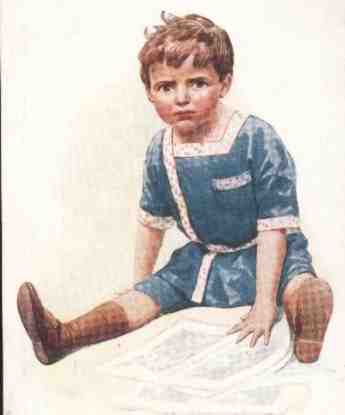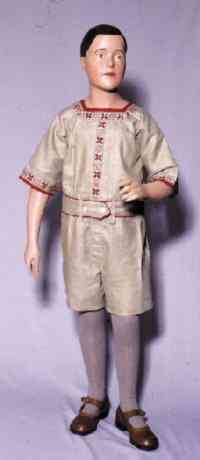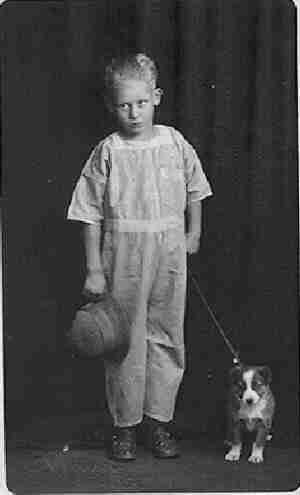
Figure 1.--Russian blouse suits had comfortable-looking open necks. They were little boy play suits, worn with short pants. This drawing comes from a pre-World War I postcard. This looks to be a two-piece suit.
Russian blouse suits came in two styles, one-piece and two-piece
suits. These open, square collared suits were seasonal wear, usually
worn during the summer. These one piece suits, like tunic suits,
were usually belted
garments, although the belt which might have a button or two, were
usually purely ornamental. They
were almost always short pants suits, rarely made with knee pants or
knickers. An attached belt made as the same material as the suit
was an important stylistic feature of these suits. Some suits had
embroidered work.
: I am for now calling these suits Russian blouse
suits. I am not sure this is the proper name as I have not yet found any written material
on this style. I notice that British and French sailors
wore this style of blouse. If HBC visitors have more details on this style,
please let me know.
I estimate that Russian blouse suits were most common from 1900-1920.
I am not sure if they were worn before the turn of the century. They might
have been worn during 1895-1900, but this requires further information.
They may have been worn in the early 1920s, but I believe they rapidly
declined in popularity after 1920.
Russian blouse suits came in two basic styles, one-piece and two-piece
suits. While these were the basic styles, there were many refinements
and stylistic embellishments.
Some of these suits were one-piece, belted garments. The upper part had the square, open collar. The bottoms were short pants. I have not yet noted these
suits with long pants.
I'm not sure how the one-piece suits were put on. They appear to be
one-piece suits, but I am just working from available images. Perhaps
there are buttons at the back, rather like a
reverse jump suit.

Figure 2.--Notice the comfortable open collar of this Russian blouse suit. Similar suits in cream satin were often worn by the sons of the German Crown Prince at the turn of the 20th Century. |
The two piece suits were simple Russian blouses with matching short
pants. Like the one-piece suit, I haven't seen Russian blouses worn
with knickers or long pants, in part because these suits were mostly made
for younger boys.
The jacket or tunic part of the Russian blouse suit varied. The ones to be worn with
short pants were relatively short pants were generally shorter than the ones made
to be worn with knickers. The tunic or blouse for short pants, syits fell just a little
below the waist. The ones made to be worn with knickers were more kikely to be worn just above knee length.
These open, square collared suits were seasonal wear, usually
worn during the summer. The open collar and accompanying short pants
suggest that they were only worn during the warm summer months.
I have no real details on color, almost all of the images I have
show the Russian blouse suits in lighter collars. Even when a color
like blue was worn, it was lighter shades. Most suits had waist and
vertical trim running to the shoulder in contrasting colors, some with
embroidery.
These one piece suits, like tunic suits, were usually belted
garments, although the belt which might have a button or two, were
usually purely ornamental. An attached belt made as the same material as the suit
was an important stylistic feature of these suits.
Most of these suits had trim at the collar, sleeve cuff, a vertical stripe from waist to shoulder or collar, and at the waist. The vertical trim was usually set off to
one side and ran to the shoulder. Less common was a velvet trim set in the
center running to the collar. Some suits had embroidered work rather then
simple contrasting color.
Most were made with short sleeves in keeping with
the seasonal style. Some had breast pockets. The sleeves were generally
cut at elbow length.
Russian blouse suits were almost always made with knickers or short pants.
While Buster Brown suits were primarily worn with aboce the knee knickers, Russian
blouse suits were more common with short pants. There were a few suits made with
long pants. These long pants suits were primarily American, but they were not very
common.

Figure 3.--Some Russian blouse suits were made with long plants. This was primarily an Ameican style. This image was probably taken about 1920. Note the double strap sandals. |
I'm not positive what type of headgear was worn with Russian blouses.
I think wide-brimmed sailor hats may have been the most common in the 1900s
and probably sailor caps in the 1910s. This requires, however,
further research.
These suits were mostly worn with short socks. Some boys, especially
in Germany, may have worn them with long stockings on cooler days, but
I believe that short stockings were by far more common.
These suits were often worn with strap shoes or sandals as the British
called them. Red shoes were especially possible.
Russian blouse suits were almost always short pants suits, rarely
made with knee pants or knickers. Most of the shorts were rather long,
knee-length shorts, despite being made for younger children. This was
the style of shorts worn in the early decades of the 20th Century.
I believe these suits were exclusively worn by boys. Girls at this time did
did not wear short pants, even under tunics and blouses.
I believe that these Russian blouse suits were basically play suits.
A nice one with fancy embroidery might be reserved for informal occasions,
but I believe this was mostly used as a play suit.
These suits were worn by younger boys. As mothers began to outfit boys
less in dresses, especially by the 1910s, informal play outfits like these
as well as
rompers became increasingly popular. These suits were generally
worn by boys from about 3-6 years old. Some older boys did wear them.
The German princes appear to have worn them to about 8-9 years of age.
The material varied, but linen was popular. Dressy suits for affluent
families, might be made of satin. The German crown princes, for example,
were often dressed in this fashion. The sleeves were often cut short at
the elbow.
These suits were worn in both
Europe and America from the late
1890s through the 1910s, although they appear to have been most popular
in Europe.
Navigate the Boys' Historical Clothing Web Site:
[Return to the main Main Russian collar page]
[Russian tunics]
[Russian blouse suits]
[Buster Brown suits]
[Sailor tunics]
[Russian blouses]
[Rompers]
[Smocks]
[Sailor suits]
[Short pants]
[Shortalls]
[Eton suits]
Navigate the Boys' Historical Clothing Web Site:
[Introduction]
[Chronology]
[Clothing styles]
[Biographies]
[Bibliographies]
[Biographies]
[Activities]
[Countries]
[Boys' Clothing Home]